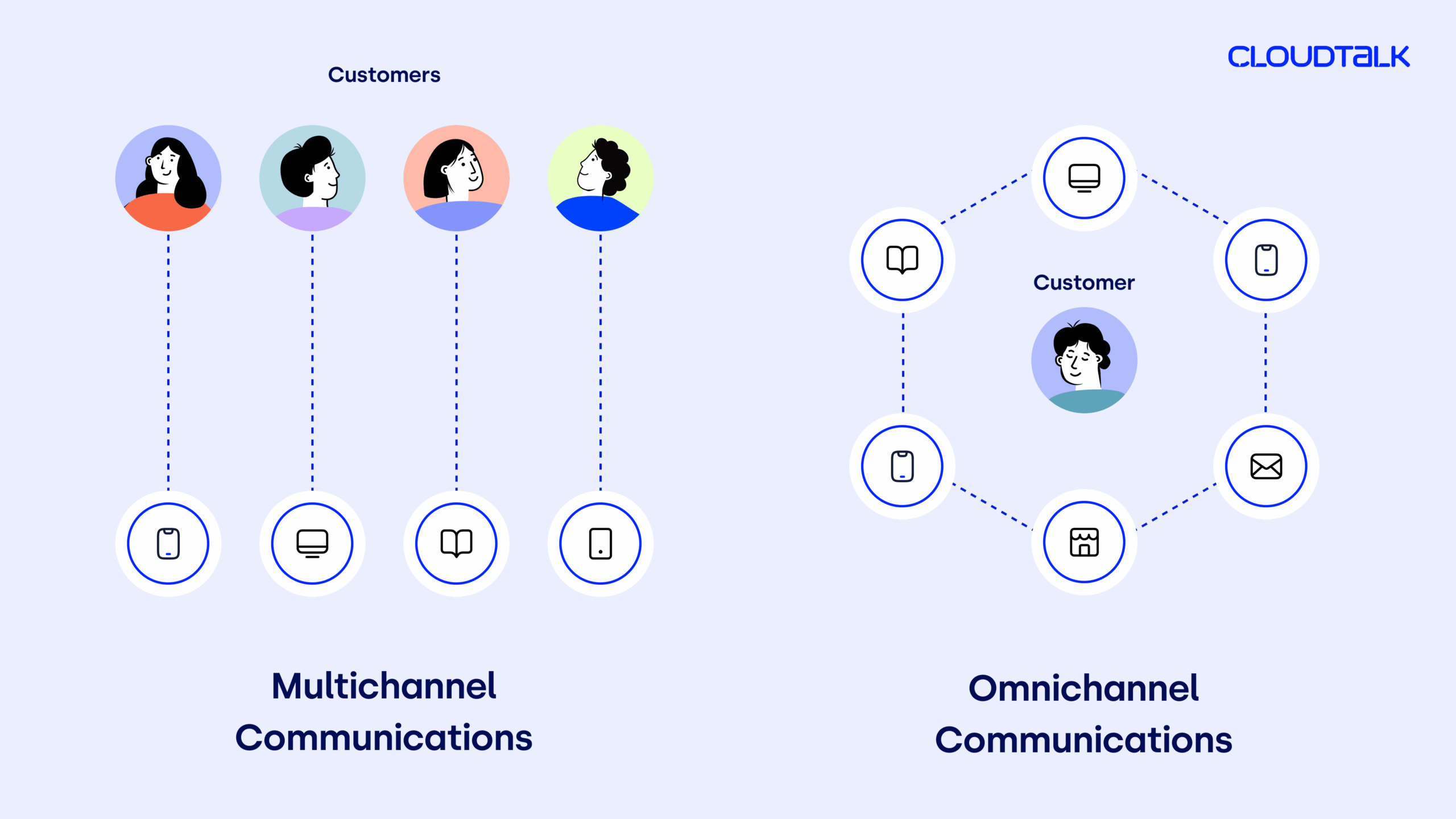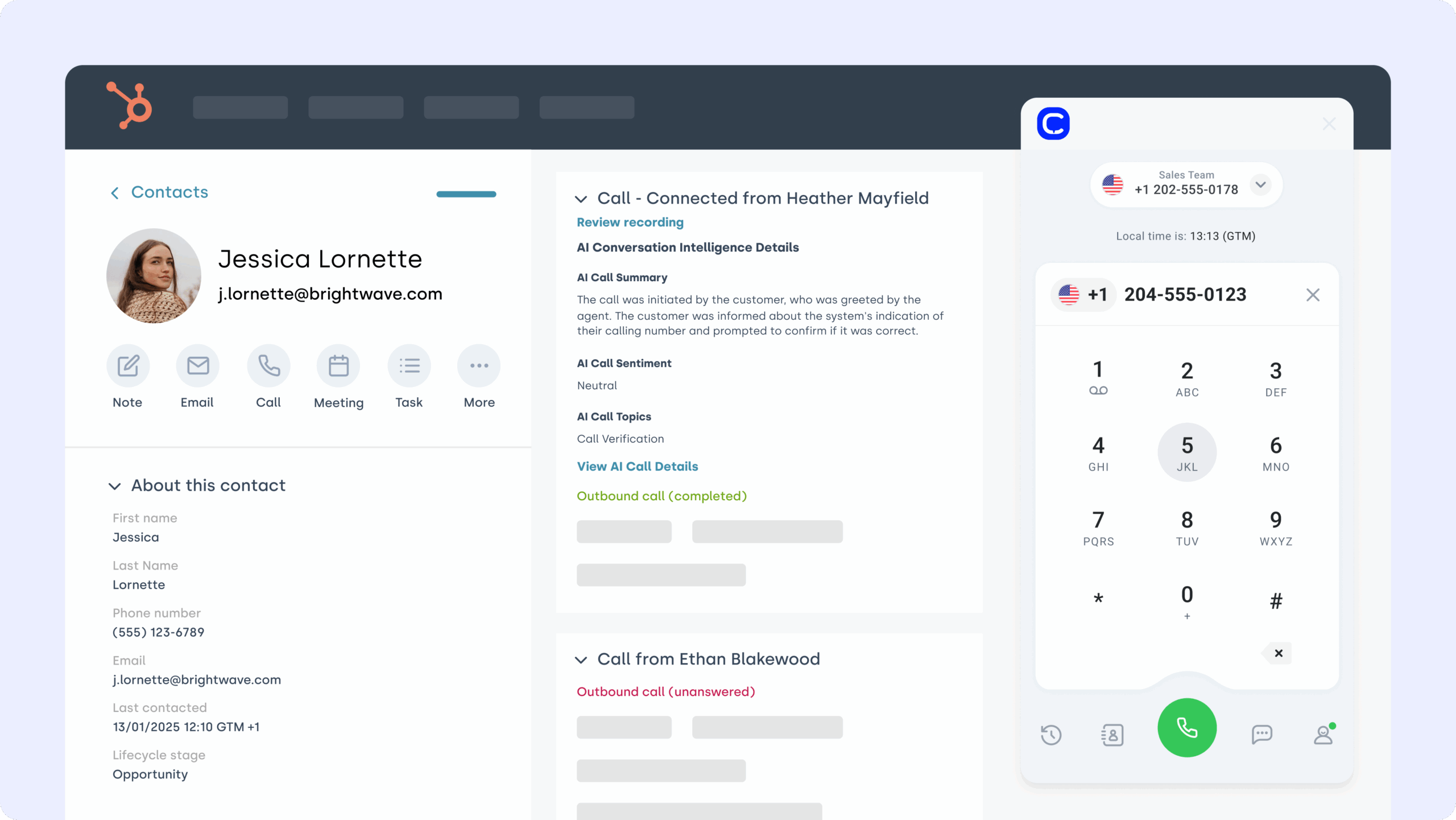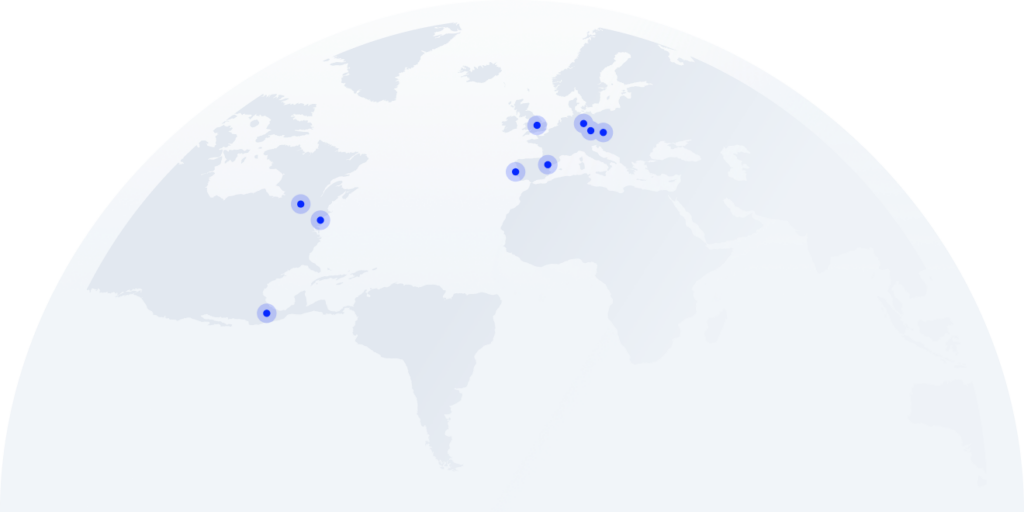Companies that nail omnichannel strategies see 33% higher satisfaction rates and 25–35% cost savings when service is seamless across channels.¹
In this guide, we’ll break down what omnichannel customer service really means, how it compares to multichannel, the benefits and challenges, plus real-world examples and the 4 C’s you need to master.
Key takeaways
-
Omnichannel connects every channel into one seamless journey, while multichannel simply offers options without the glue.
-
Companies that adopt omnichannel customer service see measurable gains: higher satisfaction, faster response times, and stronger retention.
-
The 4 C’s of omnichannel (Consistency, Convenience, Context, and Customization) define what a great customer experience looks like.
-
Real-world examples from retail, banking, healthcare, and more show how omnichannel communication creates loyalty.
-
Mastering omnichannel means fewer frustrated customers, more efficient teams, and a healthier bottom line.
Turn missed calls into opportunities.
What Is Omnichannel Customer Service?
Omnichannel customer service = all support channels (phone, chat, email, social, SMS) connected into a single platform with shared data.
With omnichannel customer service strategies, customer info, conversation history, and context don’t live in separate silos. Instead, when someone switches from, say, live chat to a phone call, the agent sees the full thread in one dashboard, helping to avoid customer service mistakes.
Integrations with CRMs, helpdesks, or ticketing tools keep everything updated automatically, so no matter where the conversation happens, the system recognizes the customer and picks up right where things left off.
”Customers love it. If they miss us, the system automatically calls them back and connects them to a live agent. It feels proactive, and customers notice.”
This matters for a couple of reasons:
-
Customers don’t have to repeat themselves; their customer history follows them.
-
Agents get the full picture of the customer right away, meaning they don’t have to put customers on hold while they look up their information.
-
Centralized data means businesses can more easily pinpoint issues.
What is the Difference Between Omnichannel and Multichannel Customer Support?
Multichannel means you give customers lots of options for communication—phone, email, chat, X, carrier pigeon, whatever. Each one is a door into your support team. It’s flexible, it’s practical, and it works. Most growing businesses start here because it gives customers choice without overcomplicating things.
If multichannel is various doors all leading to your support team, then omnichannel customer support is one open floor plan—walk in anywhere, and you’re already in the same room.
Every channel is linked together, so customers can hop between them without losing context. Start on chat, move to email, switch to phone—your story travels with you. It’s a powerful customer service technique for enterprises handling huge volumes of interactions.
Omnichannel is best for:
Multichannel is best for:
Make Customer Support Simple (and Flexible)
What are the Benefits of Omnichannel Customer Service?
-
Simplified Customer Experience: Customers can start a conversation on one channel and pick it up on another without repeating themselves—making support feel effortless.
-
Faster Resolutions and Less Frustration: Agents can see all customer interaction history in one unified dashboard, reducing handling times and dead-ends.
-
Hyper-Personalized Service: Unified data across channels lets agents customize interactions based on customer history and preferences.
-
More Convenience: Being reachable on preferred platforms—email, chat, social, phone, SMS—gives customers choice and ease.
-
Increased Trust and Transparency: Consistent messaging across interactions builds confidence. Every agent speaks the same language, backed by shared convo history—a hallmark of omnichannel communication for customer service.
-
Enhanced Brand Reputation: Delivering seamless, reliable support increases satisfaction and positions your brand as dependable.
-
Increased Sales and Higher Conversion Rates: Research shows omnichannel customers spend more—and stay longer. Companies with true omnichannel strategies report significantly higher retention (up to 89%) and year-over-year growth.²
See CloudTalk in Action
Omnichannel Customer Service Examples and Use Cases
Retail: Seamless Online & In-Store Support
Retailers like Disney, through its My Disney Experience and MagicBand programs, integrate website planning, mobile apps, and in-park tools. Guests can book experiences, check wait times, and even order food—all with one consistent interface that follows their journey. Similarly, Home Depot, Target, and Walmart use Click & Collect (buy online, pick up in store), for added convenience and a potential impulse purchase during pickup.
Banking: Secure, Multi-Channel Transactions
Modern banks let you open a loan via mobile, talk to an agent over the phone, or visit a branch—while keeping everything connected. Institutions like Wells Fargo and Chase integrate mobile apps, branches, live chat, and email into one coherent support experience, letting users manage transfers, deposits, or appointments seamlessly across platforms.
Travel & Hospitality: Cross-Channel Trip Management
Travel brands like Marriott International ensure bookings, personalized offers, and loyalty program details sync across mobile, web, and physical locations, for personalized experiences at every touchpoint. Bloomreach employs omnichannel strategies that take website visits, in-app searches, booking engine, marketing emails and meld them into one piece.
E-Commerce: Proactive Delivery Notifications & Unified Journeys
Retailers such as Casper, Glossier, and Peloton use integrated channels—email, mobile apps, showrooms, and social—to create personalized, connected experiences. For example, Casper allows customers to browse online, visit physical sleep shops, and request easy returns—all while keeping their preferences intact. Setting up proactive alerts like order status updates, delivery reminders, and OTPs via SMS or email ensures worry-free journeys.
Healthcare: Patient Engagement Across Platforms
Healthcare providers are getting more seamless with omnichannel systems that unify in-person, portal, app, and phone interactions. Institutions like UPMC Health Plan pioneered this approach, enabling patients to access records, schedule appointments, or talk to providers through any channel without disruption. Features like telemedicine, appointment reminders, and secure messaging provide convenience and care continuity.
Telecom: Technical Support Across Channels
Telecom operators using software like CloudTalk use real-time analytics and omnichannel dashboards to anticipate support needs. Infobip showcases how telco giants optimize customer engagement across SMS, voice, and app notifications—while maintaining dialogue context through automation. Additionally, advanced systems predict user experience issues before they even call support, helping reduce churn and improve response times.
Stop Juggling. Start Talking.
Omnichannel Customer Service Challenges
So, you’ve decided to go omnichannel. Bold move. Here’s how to make it out alive:
1. The Bermuda Triangle of Customer Info
Data silos, when customer information is isolated to one department or system, means that customers go full Groundhog Day and have to repeat themselves everytime they speak with a new rep or agent.
Survival tip: integrate your systems so context follows the customer, not the other way around.
2. Legacy Tech Quicksand
Your trusty old CRM may be loyal, but it doesn’t want to sync with your new chatbot. Spoiler: forcing them together usually ends in chaos.
Survival tip: choose platforms like CloudTalk that have updated integrations, or risk sinking into spreadsheet purgatory.
3. Mixed Messages (Literally)
On Twitter you’re witty, on email you’re stiff, and in-store you’re… whoever showed up that day. Customers shouldn’t feel like they’re dating three different brands.
Survival tip: unify your tone and messaging so customers always know who they’re talking to.
4. Agents vs. Every Channel Ever
Today’s agent is part therapist, part tech support, part speed-texter. Without training, it’s like throwing someone into a circus act with no rehearsal.
Survival tip: arm agents with cross-channel training and context so they don’t burn out juggling.
5. Bots Gone Wild
Bots are great until they turn into overzealous bouncers: “Sorry, you can’t talk to a human.” Cool, thanks.
Survival tip: let bots handle the easy stuff, but always give customers an exit ramp to a real person. Because nobody likes being trapped in an AI escape room.
TL;DR
Survive the Customer Service Jungle.
Tips to Provide the Best Omnichannel Customer Service
You want to be omnichannel? You want to be Everything, Everywhere, All at Once? Let’s get you there—without losing your mind (or your customer’s).
-
Ensure Consistency Across All Channels: Your tone, branding, and info should match whether you’re chatting on Facebook, texting on WhatsApp, or the aforementioned carrier pigeon. Customers shouldn’t get a warm hug on Instagram and a cold shrug via email. Keep it consistent, or prepare for chaos.
-
Integrate Customer Data and History: If a customer has to start from scratch every time they switch channels, that’s not omnichannel—that’s amnesia with a UX problem. Your agents need a full customer view: orders, preferences, past complaints and whatever you do, avoid data silos.
-
Offer Smart Self-Service Options: Most people would rather solve a problem themselves than wait on hold listening to instrumental Coldplay. Give them FAQs, knowledge bases, or a chatbot that’s actually helpful.
-
Train (and Actually Empower) Your Team: Don’t just toss your agents into a hoard of hungry zomnies…Train them. Give them tools. Let them solve problems without needing five levels of approval. And while you’re at it, remind them what professionalism in customer service actually looks like.
-
Monitor the Journey, Then Optimize the Heck Out of It: Track where customers drop off. Identify which channels are thriving and which are dead air. Is your WhatsApp crushing it, but your web chat is giving ...but your web chat is giving Her energy. (Tries to connect. Ends up weird.) Fix it. Keep iterating. That’s how you go from “meh-channel” to omnazing.
Build a Better Omnichannel Customer Experience
Delivering great support today means more than just showing up on every channel—it means showing up with context, consistency, and confidence. That’s the power of omnichannel customer care: one experience, fully connected, wherever your customers reach out.
Whether you’re looking to improve your current customer service strategy or explore what a true omnichannel customer experience looks like, it all starts with the right tools.
At CloudTalk, we help teams create seamless, multichannel support that feels just as good for your agents as it does for your customers.
See what smart, scalable customer service looks like
Source
- 01
- 02

















